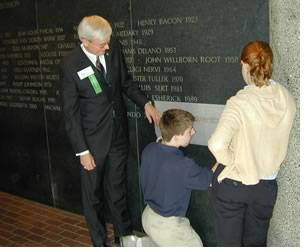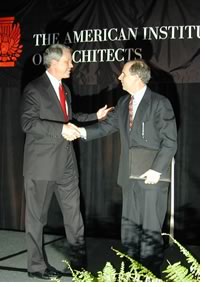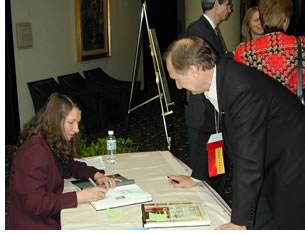

03/2004
800 AIA Leaders Explore
“Serving Our Members, Our Profession, Our Communities”
Largest-ever Grassroots Leadership Conference
kicks off in Washington, D.C.
“The fact that the AIA is represented by so many capable and dedicated leaders is evidence of our health as an organization and our vitality as a community,” said AIA Executive Vice President/CEO Norman L. Koonce, FAIA, as he welcomed nearly 800 AIA officers and component executives to the opening session of the 2004 Grassroots Leadership Conference Wednesday afternoon, March 3, in Washington, D.C. Koonce told the group that the word “community” was bound to come up a lot in the next few days as the members of the AIA explore the concept of shared values.
 AIA
President Eugene C. Hopkins, FAIA, opened the session by sharing what
happened to him just moments before he stepped up to the podium. He had
the privilege, he said, to escort the Mockbee family over to Institute
headquarters, to see the name of the late Samuel “Sambo” Mockbee
engraved in the black granite wall that holds the names of all Gold Medal
recipients. “To see them touch the wall was a very moving experience,”
Hopkins said. “We were able to show them how much we honor Sambo.”
AIA
President Eugene C. Hopkins, FAIA, opened the session by sharing what
happened to him just moments before he stepped up to the podium. He had
the privilege, he said, to escort the Mockbee family over to Institute
headquarters, to see the name of the late Samuel “Sambo” Mockbee
engraved in the black granite wall that holds the names of all Gold Medal
recipients. “To see them touch the wall was a very moving experience,”
Hopkins said. “We were able to show them how much we honor Sambo.”
Hopkins then introduced the conference’s theme of “Serving Our Members, Our Profession, Our Communities.” “The key word is serving,” he explained “. . . and the focus of that service is the AIA’s 72,000 members; 100,000 members of the architecture profession; and the nearly 300 million men, women, and children who live, work, and play in our communities all across the nation.”
Hopkins said that although, in terms of size, America’s architects are a small profession, “in terms of our impact on this nation’s prosperity, jobs, health, healing, education, sustainability, land use, and overall quality of life—we are huge, and we must not lose sight of our impact.”
 No
little plans
No
little plans
Hopkins in turn introduced AIA President-elect and Grassroots Chair Douglas
L Steidl, FAIA, who challenged the group over the course of the conference,
to “stretch our definition of what we belong to.”
“Let’s begin to think of ourselves in a larger, more energizing, and more supportive context,” Steidl suggested. “It’s my hope that by Saturday we’ll no longer think of ourselves solely or even largely as representatives of any single constituency, but as leaders of a vital, diverse, and inclusive professional community.”
Steidl reminded the participants of Daniel Burnham’s exhortation to make no little plans. “With that in mind, I want to advance a huge claim for this organization and this profession,” he said. “The quality of the built environment on this planet—indeed the health of the planet itself—is unusually dependent on us—individually and collectively . . . Acting collaboratively and with purpose, we have the power, as architects acting through the AIA, to mold our future so that we can make a positive difference for our profession, our community, and this planet.”
When we are guided by service, Steidl reminded the audience that we immediately transcend our own narrow world and begin to embrace others in our profession and communities.
Holding up a mirror
Proclaiming that the conference would begin by “holding up a mirror
to the AIA and to architects,” Steidl introduced Jamie Rice, creative
director of Carton Donofrio, the Baltimore-based advertising agency that
conducted research for the AIA to ascertain the value of the AIA “brand”—what
the expectations are when members, the profession, the industry, clients,
and the public hear “AIA.” Rice explained that the research
entailed talking to architects and others across the country in 18 sessions,
in an attempt to distill the essence of the values of the profession.
He reminded the audience that the AIM (Aligning the Institute for the
Millennium) strategic long-range planning report envisions “one
AIA with shared values.”
Rice explained that the research pointed out the paradoxes within the profession; for example, that it is about “standards, yet prizes innovation.” The research also led to development of a “Mr. AIA” (the typical architect who is a 45–55 years old, white male who is rich—or likes to look that way, and “artsy—with cool glasses”). Most importantly, those interviewed overwhelmingly say that “the AIA is architects,” and should be needs-centric, not structure-centric, and recognize all communities of interest.
Rice concluded that “the task now is to move from discussion to action.” The research has led to development of a new aim for the Institute, developed by the Brand Steering Committee. Under the aegis of the slogan “Architects Together: Knowledge, Community, Advocacy,” it states simply: “Our aim is to help each other put our talents to work to create better places for people.” The group has set up a resource on the AIA Web site, www.aia.org/brand, which offers the results of the research plus a bulletin board through which architects and components can share ideas.
 Language
of engagement
Language
of engagement
Steidl then introduced Sarah Susanka, AIA, architect and author of the
Not So Big House books, whom,
he said, was working to create a “language of engagement”
to replace “archispeak” for clients in the residential arena.
Susanka gave a brief history of the architectural influences in her life,
which have included the works of Kahn, Wright, Pei, Le Corbusier, and
most notably Christopher Alexander’s A
Pattern Language, and how they have led to her life’s work
of engaging the public about architecture. Over a 20-year career, much
of it in residential design, she has developed a sort of pattern language
of her own, which gives clients a framework of design principles by which
they can start describing what they really want in a home. The principles,
grouped under the headings of space, light, and order , are described
in her new book, Home by Design,
released by publisher Taunton Press March 1.
 People
are desperate for details—something that gives personality to where
they live—and for ways to make space more comfortable. Susanka reminded
the audience that the concepts are not new to architects; in fact, they
are second nature. However, the public doesn’t grasp that the feelings
of “home” they desire come under the purview of architects.
“You’ve got to tell them your story—it’s hugely
important,” she said. “It’s about simple solutions to
everyday problems. Middle America is looking for better options. You just
need to make them aware of what architects do.”
People
are desperate for details—something that gives personality to where
they live—and for ways to make space more comfortable. Susanka reminded
the audience that the concepts are not new to architects; in fact, they
are second nature. However, the public doesn’t grasp that the feelings
of “home” they desire come under the purview of architects.
“You’ve got to tell them your story—it’s hugely
important,” she said. “It’s about simple solutions to
everyday problems. Middle America is looking for better options. You just
need to make them aware of what architects do.”
Following her presentation, Susanka signed books for those in the audience eager to learn more about Home by Design. Then it was on to the annual Accent on Architecture gala at the National Building Museum.
Copyright 2004 The American Institute of Architects.
All rights reserved. Home Page ![]()
![]()
 |
||
| Purchase
Home by Design from
the AIA Bookstore. Learn more about Susanka’s Not
So Big House concepts and her new book, Home
By Design. Read more about the AIA Brand.
|
||